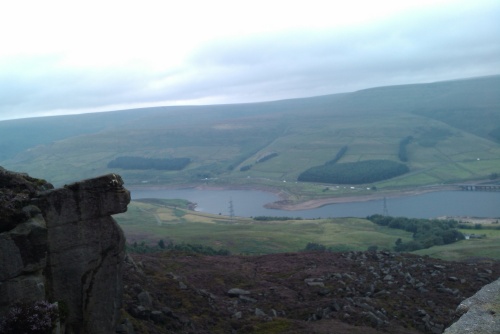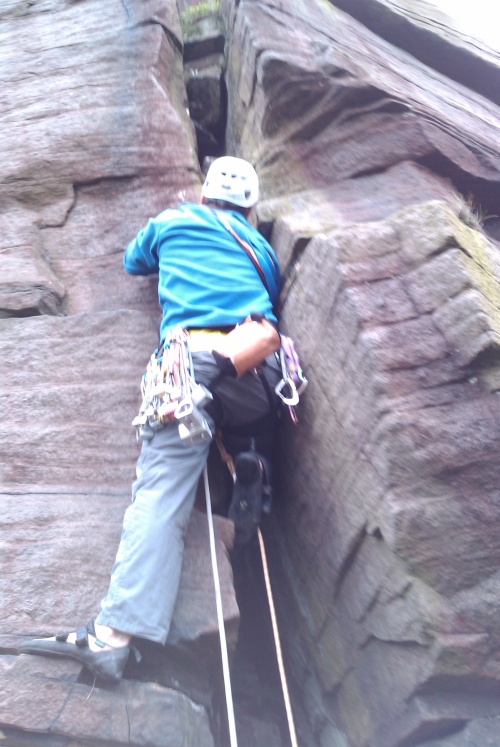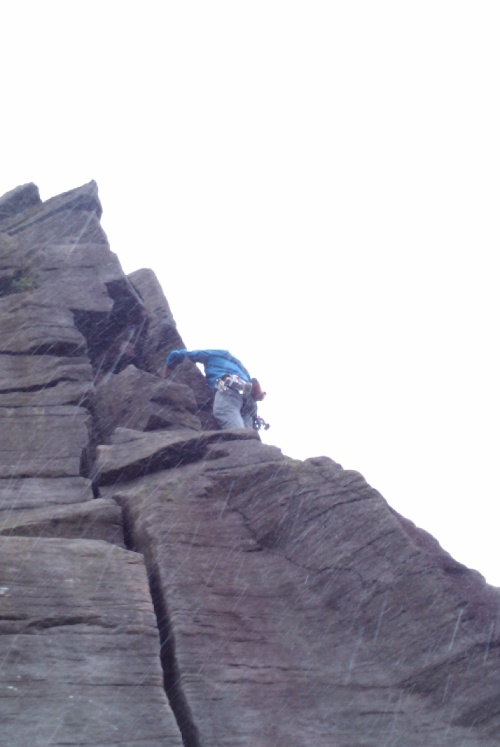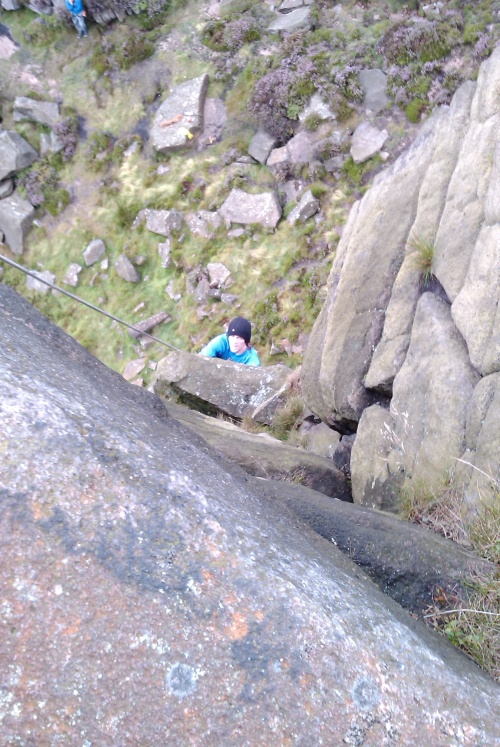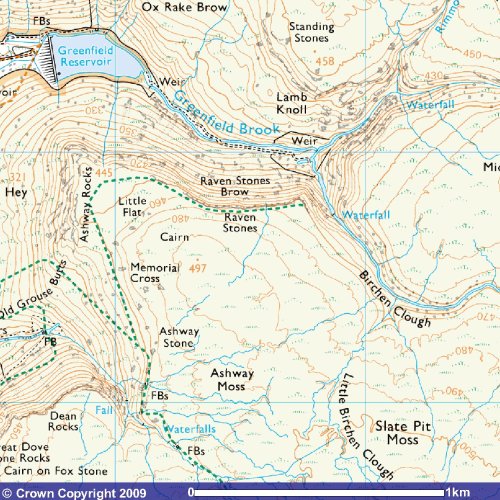this one’s a bit late too … Wednesday 3rd September 2009
Wet Wet Wet
Early start, up before six move quietly, don’t wake the boy, don’t disturb the wife’s sleep. Out of the house unshowered, walk the dog. Just before dawn, kids back to schools, everyone back to work. A few other early risers in the gloom signals summer’s over. Back in the house, out of the wind, breakfast, flask of coffee and final things in the bag and pockets. Stirrings in the house, child awakes, knock at the door, goodbyes said, in the car, go. A day, a day not bracketed by other responsibilities. A day in the mountains long planned and hard won. Having moved from the Vale to the high Pennine moors, I am driven harder to find more height, steeper rock and longer routes. To spend all day on one face steadily unpicking the line among ridge, groove, arete, rib and slab instead of endless up and downs trying to push grades.
Choice of location and route all up in the air because of the weather. Lakes ruled out because all the forecasts look appalling. This rules out Troutdale Pinnacle and Bridge’s Route on Eskdale Buttress (Dow Crag). Wales becomes the destination of desperation based on a lone optimistic forecast and a guide suggesting Glyder Fawr or even Lliwedd can be climbed in the wet. We head for Pen y Pass scoping the weather (actually optimising the breaks in the rain) as we go west. We parked up about 10 am and did some preliminary sorting of gear, checked the weather report in the cafe and waited for a break in the rain.
It’s one long Diff – Slanting Buttress Ridge Route on Lliwedd, “good except in the foulest conditions” – well it was only raining. It kept on raining as we made the walk up the Miner’s Track and round the lake. It kept raining more or less heavily as we skirted the bogs and streams crossing the path as best we could and headed switchbacking up the scree. The advice in the guidebook was to sort out your position from a distance – a bit tricky what with the visibility low and all the rain. Chevrons of quartz were finally distinguished, the base of the route established. More water was added to the ground when I wrung out my hat. Big boots and ‘sacks were going to be the order of the day. Andrew led off up the first pitch, easy climbing but care needed in the wet. I took the second only putting a couple a pieces of gear and setting up a belay on a small spike and very small wire. Water was getting into boots and penetrating through layers of clothing. As Andrew set off up pitch 3 it was a real struggle over some tricky blocks, then a hands and knees (“it’s the only friction!”) climb up a slab disguised as a waterfall. Weatherwise, things looked a little better. Inevitably, by the time he set up the belay I could barely see him for low cloud.
The absorption of water was matched by the absorption in the tasks in hand. This climb required focus on the job in hand, a re-experiencing of climbing technique (in some cases its complete abandonment) to re-learn everything in a watery environment. Friction, small toe holds – these things were useless now. Yet the climb wasn’t without delicacy, balance was much needed and sometimes sheer thuggery required to pull and mantel to the next hold.
We stopped for a while at the next stance taking shelter in an overhung corner as the rain turned to hail. We took coffee and I rolled a cigarette. Unable to dry my hands the paper was damp but not quite at the point of disintegration. Was it quarter to three at this point? My guidebook, inside three layers of clothing was beyond reading. Later it would be a papier mache block. The valley bottom and the lake remained out of view as did anything to the left of Slanting Gulley. With little to see and only Andrew’s calling out of the route instructions to guide me I took off again. The pitches lost their distinctiveness from one another, after I stepped round a nose onto the ridge the route lost it’s distinctiveness from the rest of the mountain. Grassy ledges and ramps were employed, blocks swung over and spikes belayed from. More water, a bit more wind, more cloud. Another steep corner on my lead. I’m in the groove now, I’m thinking ahead looking for the holds, trying to climb efficiently, so wet I no longer notice the rain. More gear required for this pitch. I’m faced by a slab four, five, six metres high, crack up the middle, a wrinkled wall on the right a more broken one on the left but only to about a third of the height. I tried moves all over these three walls, crossing the slab, holdless apart from a vertical hand crack. I go back and forth each time trying to keep my large boots planted on rock somehow. I offer it to Andrew – different folks and all that. He declines, modestly. I bob up and down looking for a sequence of holds that will get me up and over and out of this dead end. I swing on the rope, pull on slings and the rope. Finally I stand in a sling clipped to a nut placed as high as I can reach in the crack. Time’s passed again, three or more hours. It doesn’t go anywhere, we call it off. I downclimb as best I can leaving a nut in to be lowered off. We lose another at the belay which is just jammed.
Another (yet another) huddled dripping discussion debate. More attempted location finding, this time in relation to the descent gulley and just get on and abseil down. Andrew’s guidebook is protected by a state of the art sandwich bag. We go down reversing the previous pitch. Then take a long abseil on the right of the ridge that uses up most of the ropes, this has taken out virtually all of the climb. Another short abseil drop and we’re on the descent route picking our way on the scree, round the toe of the buttress. All that abseiling has forced most of the water out of the ropes which we can repack into the sacks.
What light there is fading away as we regain the path to take us around the toe of the buttress. In the wet this is as tricky as anything else we’ve done today. Thankfully we’re too wet to take on much more water. As the literal and slightly metaphorical gloom descends we take the path that brought us here. Warming up as we move more quickly against the weather we say little. A combination of weather and, on my part, relative inexperience on long mountain routes gave the trip a frontier feel. Andrew might have just felt wet through and pissed off. If so, he was too polite too mention it. In the dark every glimpse of artificial light seemed to me like the end of our trudge. But it wasn’t like that. Eventually we got to the car at Pen y Pass, still raining. By 9.30 pm we were standing in our underpants wringing out our clothes and ready to hit the road back to the Pennines once we’d found the dry gear and got it on before it got wet as well.
Was it a failure, not finishing the route and striding manfully across the top of the mountain to the miners track? Was it a victory for common sense and tiredness to come down by whatever means possible? I think it was just fine to have had an idea and pursued it with all physical strength, technique and willpower available. After all these days routes are all but labelled on the rock and the experience of not actually completing a climb is pretty rare. End of the summer it certainly was. If we start earlier in the season next year we might get some better weather but we might never get a better challenge than Slanting Buttress Ridge Route in the wet. It took a fortnight to dry the guidebook out. Andrew’s phone was never the same despite taking it apart to dry it out on the way back. All this, long planned and hard won, and life’s the richer for it.
Read Full Post »


